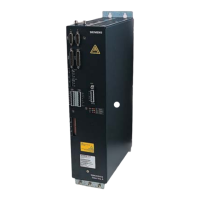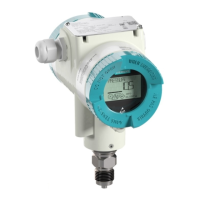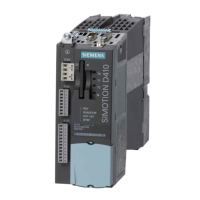6
6.4 Input/output terminals of the control board
6-520
Siemens AG 2005 All Rights Reserved
SIMODRIVE 611 universal Description of Functions (FBU) – 04.05 Edition
Table 6-49 List of output signals, continued
Operating
mode
Signal name, description PROFIBUS bitposn–setFct. No.
Fixed endstop reached (from SW 3.3) 68 – x PosZsw.12
This output signal is used to display whether the drive is in the ”fixed endstop reached” status.
1 signal The drive is in the ”fixed endstop reached” status
0 signal The drive is not in the ”fixed endstop reached” status
Note:
The ”fixed endstop reached” status is assumed, dependent on the setting in P0114 (fixed endstop,
configuration 2).
The ”travel to fixed endstop” function is described in Chapter 6.12.
Request passive referencing (from SW 5.1) 69 – x ZSW1.15
The master drive requests passive referencing for the slave drive, using this output signal.
To realize this, this output signal must be logically interlocked with the input signal ”request passive refer-
encing” for the slave drive.
1 signal The master drive has detected its zero mark
This means that for the slave drive, the reference cam and zero mark search are activated
While the signal is set, the slave axis must move over a zero mark otherwise an appropri-
ate fault is signaled.
0 signal The master drive has reached its reference point
Note:
If, for a double–axis module P0891 (B) = 1, this means that the position actual value from drive A is
internally connected to the position reference value of drive B, then the following applies:
The output signal ”request passive referencing” from drive A (master drive) is internally and automati-
cally detected from drive B (slave drive). In this case, external wiring is not required.
The ”request passive referencing” output signal is always output at the reference point approach
when the zero mark has been recognized.
The ”passive referencing” function is described in Chapter 6.3.
Tracking mode active 70 – x PosZsw.0
This output signal is a checkback signal that the tracking mode has been activated via the ”tracking
mode” input signal.
1 signal Tracking mode active
0 signal Tracking mode not active
Note:
If the tracking mode is active as internal response to an error/fault, then this is also displayed using this
input signal.
6 Description of the Functions
08.0102.02

